Viscoelastic damper connected to adjacent structure with seismic isolation system
DOI:
https://doi.org/10.61186/7.3.76Keywords:
Earthquake, Elastomeric Bearing , Isolation System, Sliding System, Retrofit, Viscoelastic DamperAbstract
Base isolation solutions are efficient alternatives for seismic protection of buildings and for enhancing resilient capacity. Currently, seismic isolation is focused principally on the critical infrastructure of public health, transportation, education, etc. The seismic response of multi storied base-isolated structure to various types of isolation systems connected using viscoelastic dampers to the adjacent dissimilar base isolated or fixed base structure is investigated. The multi- storied structures are modelled as a shear type structure with lateral degree of freedom at each floor, which are connected at different floor levels by viscoelastic dampers. The variation of top floor absolute acceleration of both the buildings and bearing displacement under different real earthquake ground motions is computed to study the behavior and effectiveness of resulting connected system. It is concluded that connecting the two adjacent base isolated buildings with the viscoelastic dampers is useful in controlling large hearing displacements in the base isolated structures thereby eliminating the isolator damages arising due to instar billet at these large displacements or pounding with adjacent ground structures during earthquakes. The viscoelastic damper connection between adjacent structures is found to be most effective when the adjacent base-isolated and fixed base buildings are competed. Such scheme is hence useful in upgrading the seismic performance of existing fixed base structures adjacent to a base isolated structure.
References
Kelly, James M. "Aseismic base isolation: review and bibliography." Soil Dynamics and earthquake engineering 5.4 (1986): 202-216. https://doi.org/10.1016/0267-7261(86)90006-0
Jangid, R. S., and T. K. Datta. "SEISMIC BEHAVIOUR OF BASE-ISOLATED BUILDINGS: A STATE-OF-THE ART REVIEW." Proceedings of the Institution of Civil Engineers-Structures and Buildings 110.2 (1995): 186-203. https://doi.org/10.1680/istbu.1995.27599
Noruzi, Faramarz, Ahmad Hasanpour, and Sahand Saeedian. "Seismic Response Assessment of high-rise RC building with Lead Rubber bearing base isolator on different soil types." Journal of Civil Engineering Researchers 0 (2017): 1-9. http://www.journals-researchers.com/ojs/index.php/jcer/article/view/23
Bagherinejad, Kamyar, Shahin Charkhtab, and Seyedhamed Hosseini. "Cost Viability of a Base Isolation System for the Seismic Protection of mid-rise reinforced concrete moment frames." Journal Of Civil Engineering Researchers 1.1 (2017): 1-7. https://www.journals-researchers.com/ojs/index.php/jcer/article/view/2
Housner, GWea, et al. "Structural control: past, present, and future." Journal of engineering mechanics 123.9 (1997): 897-971. https://doi.org/10.1061/(ASCE)0733-9399(1997)123:9(897)
Soong, Tsu-Teh, and B. F. Spencer Jr. "Supplemental energy dissipation: state-of-the-art and state-of-the-practice." Engineering structures 24.3 (2002): 243-259. https://doi.org/10.1016/S0141-0296(01)00092-X
Westermo, Bruce D. "The dynamics of inter structural connection to prevent pounding." earthquake Engineering & Structural Dynamics 18.5 (1989): 687-699.
https://doi.org/10.1002/eqe.4290180508
Zhang, W. S., and You Lin Xu. "Vibration analysis of two buildings linked by Maxwell model-defined fluid dampers." Journal of sound and vibration 233.5 (2000): 775-796.
https://doi.org/10.1006/jsvi.1999.2735
Zhang, Ri-Hui, and Tsu T. Soong. "Seismic design of viscoelastic dampers for structural applications." Journal of structural engineering 118.5 (1992): 1375-1392.
https://doi.org/10.1061/(ASCE)0733-9445(1992)118:5(1375)
Zhang, Ri‐Hui, T. T. Soong, and P. Mahmoodi. "Seismic response of steel frame structures with added viscoelastic dampers." Earthquake engineering & structural dynamics 18.3 (1989): 389-396. https://doi.org/10.1002/eqe.4290180307
Kikuchi, Masaru, and Ian D. Aiken. "An analytical hysteresis model for elastomeric seismic isolation bearings." Earthquake engineering & structural dynamics 26.2 (1997): 215-231.
https://doi.org/10.1002/(SICI)1096-9845(199702)26:2<215::AID-EQE640>3.0.CO;2-9
Koo, Gyeong-Hoi, et al. "Evaluation of laminated rubber bearings for seismic isolation using modified macro-model with parameter equations of instantaneous apparent shear modulus." Engineering structures 21.7 (1999): 594-602. https://doi.org/10.1016/S0141-0296(98)00006-6
Robinson, William H. "Lead‐rubber hysteretic bearings suitable for protecting structures during earthquakes." Earthquake engineering & structural dynamics 10.4 (1982): 593-604. https://doi.org/10.1002/eqe.4290100408
Bagherinejad, Kamyar, Shahin Charkhtab, and Seyedhamed Hosseini. "Cost Viability of a Base Isolation System for the Seismic Protection of mid-rise reinforced concrete moment frames." Journal Of Civil Engineering Researchers 1.1 (2017): 1-7. https://www.journals-researchers.com/ojs/index.php/jcer/article/view/2
Khanloo, Mehdi, Amir Masoud Hosseini, and Mohammed Reza Oliaei. "A study on effects of base isolators and dampers on steel structures design." Journal of Civil Engineering Researchers 1.4 (2017): 17-23. https://www.journals-researchers.com/ojs/index.php/jcer/article/view/19
Wen, Yi-Kwei. "Method for random vibration of hysteretic systems." Journal of the engineering mechanics division 102.2 (1976): 249-263. https://doi.org/10.1061/JMCEA3.0002106
Zayas, Victor A., Stanley S. Low, and Stephen A. Mahin. "A simple pendulum technique for achieving seismic isolation." Earthquake spectra 6.2 (1990): 317-333.

Downloads
Published
Issue
Section
License
Copyright (c) 2025 Journal of Civil Engineering Researchers

This work is licensed under a Creative Commons Attribution 4.0 International License.




